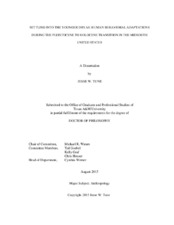| dc.description.abstract | This dissertation investigates the evolution of Paleoindian adaptations during the Pleistocene to Holocene transition in the Midsouth United States. Evidence suggests that lithic technologies became more regionalized over time as territorial ranges constricted and people relied increasingly on locally available resources.
Following a brief introduction to the issues related to Paleoindian adaptations in Chapter one, I evaluate the evidence for pre-Clovis occupation at the Coats-Hines-Litchy site, in Tennessee. I conclude that based on analyses of geochronology, site formation processes, and the lithic assemblage, the site likely predates human occupation of North America, the faunal assemblage is naturally produced, and the artifact assemblage has been redeposited from other nearby sites. I next present a lithic analysis charactering the range of variation and reduction sequence of Cumberland fluted bifaces from the Midsouth. I contend that standardization of basal elements reflect hafting requirements, and patterns of biface morphology, breakage, and resharpening reflect that Cumberland bifaces were designed specifically for piercing rather than to be multifunctional. I then compare Clovis, Cumberland, and Dalton biface technologies from Tennessee to investigate the evolution of Paleoindian adaptations during the Pleistocene to Holocene transition. I show that temporal changes in technological organization, landscape use, and toolstone selection reflect settling in processes associated with landscape learning rather than Younger Dryas-related environmental changes.
Ultimately, this dissertation presents new data related to the late Pleistocene occupation of the Midsouth and the evolution of regional Paleoindian adaptations. By recognizing temporal and spatial changes in late Pleistocene technologies, and considering those changes in relation to paleoecological records, we are better suited to understand Paleoindian adaptations. In turn, we are able to construct more robust and accurate settlement models to explain the peopling of the Americas. | en |


